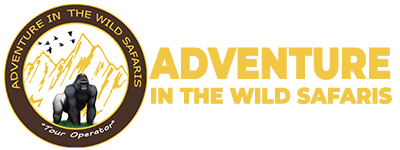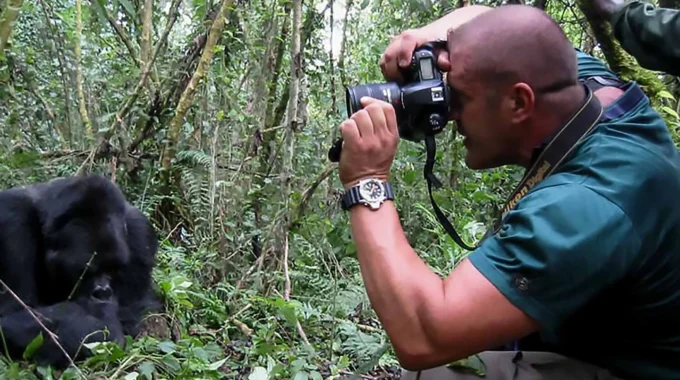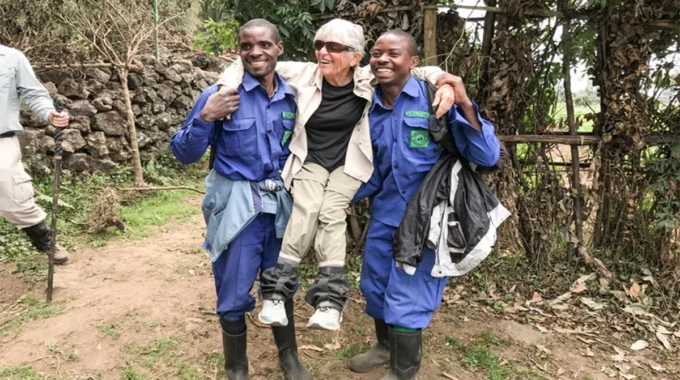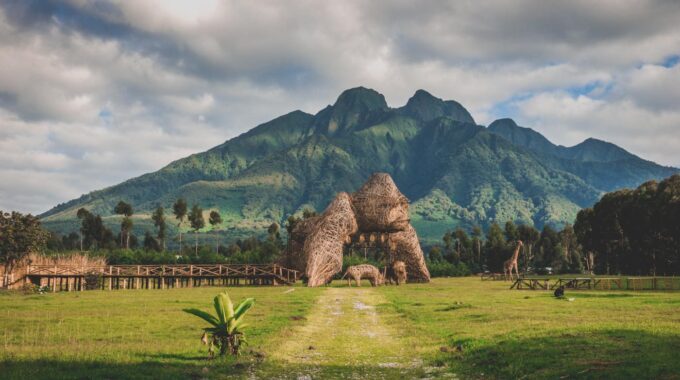Photography Tips for Capturing Gorillas in the Wild Photography Tips for Capturing Gorillas in the…
Safety Measures and Health Precautions During Treks
Safety Measures and Health Precautions During Treks: Safety measures during gorilla treks

Safety measures during gorilla treks: Gorilla trekking in Rwanda and Uganda is an unforgettable adventure, but it also demands careful preparation, awareness, and adherence to safety measures to ensure the well-being of both trekkers and the endangered mountain gorillas. Whether you are hiking through the dense Bwindi Impenetrable National Park in Uganda or the volcanic terrain of Volcanoes National Park in Rwanda, taking the right precautions is vital for a successful and responsible trek.
In this guide, Gorilla Rwanda Safaris shares essential safety measures and health precautions every trekker should know before embarking on a gorilla trekking safari in Rwanda or Uganda.
Why Safety Matters on Gorilla Treks
The trek to see mountain gorillas is not a walk in the park—it’s a moderately to physically demanding activity that often involves hiking for hours through rugged, muddy, and uneven terrain. Moreover, mountain gorillas are susceptible to human-transmitted diseases, so maintaining high hygiene standards is critical for their survival.
Whether you’re a seasoned hiker or a first-time adventurer, prioritizing your safety—and that of the gorillas—is non-negotiable.
The following is a list of safety precautions for gorilla treks:
1. Pre-Trek Health Assessment
Before joining a gorilla trek, travelers are strongly advised to:
- Visit a travel clinic at least 6 weeks before departure
- Update routine vaccinations
- Discuss malaria prophylaxis and altitude sickness medications
- Carry a certificate of yellow fever vaccination (mandatory for Uganda and Rwanda)
If you have any cold, flu, or respiratory symptoms on the day of the trek, you may be barred from participating, as mountain gorillas are extremely vulnerable to human diseases.
Trekking sick can harm gorillas—be honest about your health status.
Related Blog: Fitness Requirements for Gorilla Trekking in Rwanda and Uganda
2. COVID-19 and Infectious Disease Protocols
Since the COVID-19 pandemic, Uganda and Rwanda have implemented stricter gorilla trekking guidelines to protect the endangered species. These include:
- Wearing face masks during gorilla viewing
- Washing hands or using sanitizer before and after the trek
- Maintaining a minimum 10-meter distance (revised from 7 meters)
- Daily health screenings for trekkers and staff
Trekkers are required to follow the guidance of park rangers at all times. Gorilla Rwanda Safaris ensures all guests are briefed before the experience.
More Web Resources: Rwanda Development Board – Covid-19 Travel Guidelines
3. Travel Insurance
Travel insurance is mandatory when booking with most gorilla trekking operators, including Gorilla Rwanda Safaris. Your policy should cover:
- Emergency medical evacuation
- Trekking-related injuries
- Trip delays or cancellations
- Covid-related interruptions
Double-check with your insurance provider to confirm that high-altitude hiking and primate trekking are included.
4. Altitude and Acclimatization
Both Volcanoes National Park and parts of Bwindi reach altitudes of 2,500–3,800 meters (8,200–12,500 feet). If you’re coming from sea level, this change can cause altitude sickness.
To reduce risk:
- Arrive a few days early to acclimatize
- Stay hydrated and avoid alcohol
- Hike at a slow, steady pace
- Notify your guide if you feel dizzy or short of breath
5. Trail Safety Tips
Treks can last anywhere from 1 to 8 hours, depending on the gorilla family’s location. Be prepared for:
- Muddy, slippery trails—especially during the rainy season
- Thick vegetation that requires some bushwhacking
- River crossings and steep inclines
Safety Tips on the Trail:
- Always follow your guide’s lead
- Watch your footing and use a hiking stick
- Wear proper hiking boots with ankle support
- Stay with your group—never wander off
- Respect park boundaries and ranger instructions
Related Blog: Best Time to Visit Rwanda and Uganda for Gorilla Trekking
6. First Aid and Medical Support
All treks are accompanied by armed rangers and at least one guide trained in basic first aid. However, it’s still important to carry:
- Personal medication (e.g., inhalers, antihistamines)
- Blister plasters, antiseptic wipes, and bandages
- Oral rehydration salts or electrolyte tablets
- Pain relievers and anti-diarrheal medication
Gorilla Rwanda Safaris also equips tour vehicles with first-aid kits and maintains contact with nearby medical centers for emergencies.
7. Protective Clothing and Gear
Wearing the right gear reduces the risk of injury, insect bites, and discomfort.
Recommended Clothing:
- Long-sleeved shirts and long trousers
- Waterproof hiking boots with good grip
- Gaiters to keep mud and ants out
- Garden gloves for grabbing onto branches
- Waterproof jacket or poncho (weather changes rapidly)
Pack Essentials:
- Reusable water bottle (at least 2 liters)
- Energy snacks (nuts, granola, dried fruit)
- Sunblock, insect repellent, and lip balm
- Personal hand sanitizer and mask
8. Dealing with Wildlife Encounters
Though gorilla encounters are the highlight, you may come across other wildlife like forest elephants, duikers, or monkeys.
- Remain calm and quiet
- Do not run—follow your guide’s instructions
- Avoid sudden movements or loud noises
When in the presence of gorillas:
- Maintain a safe distance
- Avoid direct eye contact with silverbacks
- Never attempt to touch a gorilla, even if it approaches
Related Blog: Gorilla Trekking in Volcanoes National Park vs Bwindi
9. Trekking Etiquette for Group Safety
Gorilla treks are limited to 8 people per gorilla family per day to minimize impact.
Good Group Etiquette:
- Keep noise levels low
- Don’t hog photo opportunities
- Be supportive of slower hikers
- Follow your guide’s pace
- Ask permission before taking photos of guides or porters
10. Hygiene and Sanitation Guidelines
To preserve the pristine environment and prevent disease:
- Use park-designated toilets (or follow guides’ instruction)
- Carry a small ziplock bag for trash
- Never litter in the forest
- Avoid spitting or sneezing near vegetation
These guidelines are part of gorilla conservation efforts supported by Gorilla Rwanda Safaris.
More Web Resources: International Gorilla Conservation Programme
11. Porters: An Added Layer of Safety
Hiring a porter helps reduce fatigue and allows you to focus on the trek. Porters can carry your bag, assist during steep climbs, and provide balance support.
This service:
- Helps local communities earn income
- Improves your stability and safety
- Allows you to carry less gear
Related Blog: Hiring a Porter: Pros and Cons
12. Mental Preparedness and Attitude
Trekking to see mountain gorillas is not a race. The hike may be long and tiring, but a positive mindset and patience go a long way.
Prepare yourself mentally:
- Embrace the unpredictability of nature
- Focus on the experience, not the discomfort
- Respect conservation over selfies
Your attitude plays a key role in a rewarding, safe, and ethical encounter.
Final Thoughts
Safety measures and health precautions during gorilla trekking are not just about protecting yourself—they are about protecting the endangered mountain gorillas and preserving their natural habitat.
At Gorilla Rwanda Safaris, your safety is our top priority. Our expert guides, knowledgeable staff, and well-planned itineraries ensure that every trekker is prepared, supported, and informed at every step.
With the right precautions, your gorilla trekking adventure in Rwanda or Uganda will be safe, respectful, and unforgettable.
Related Blogs:
- Fitness Requirements for Gorilla Trekking in Rwanda and Uganda
- Hiring a Porter: Pros and Cons
- Best Time to Visit Rwanda and Uganda for Gorilla Trekking
- Packing Guide for Gorilla Trekking in Uganda and Rwanda



